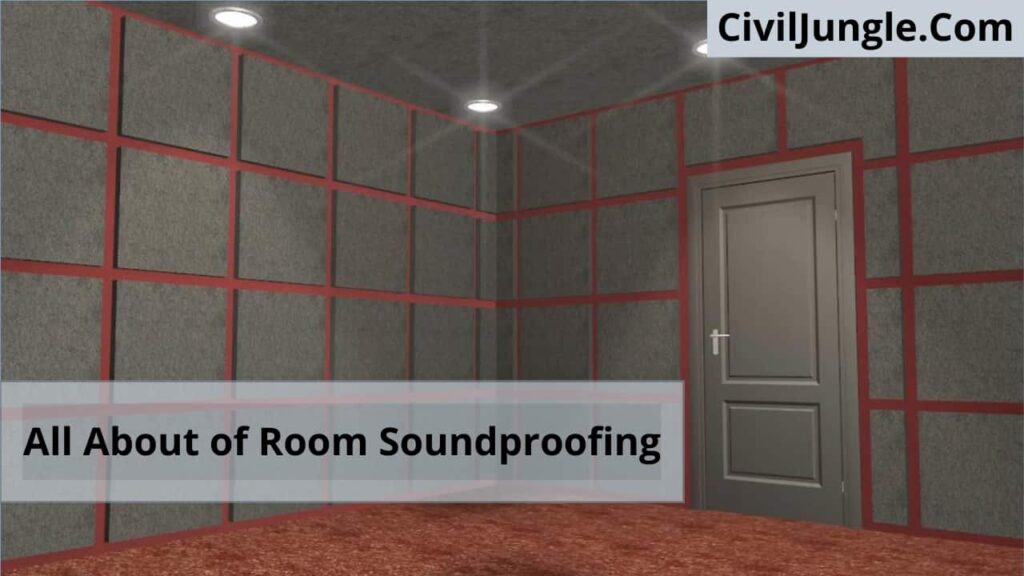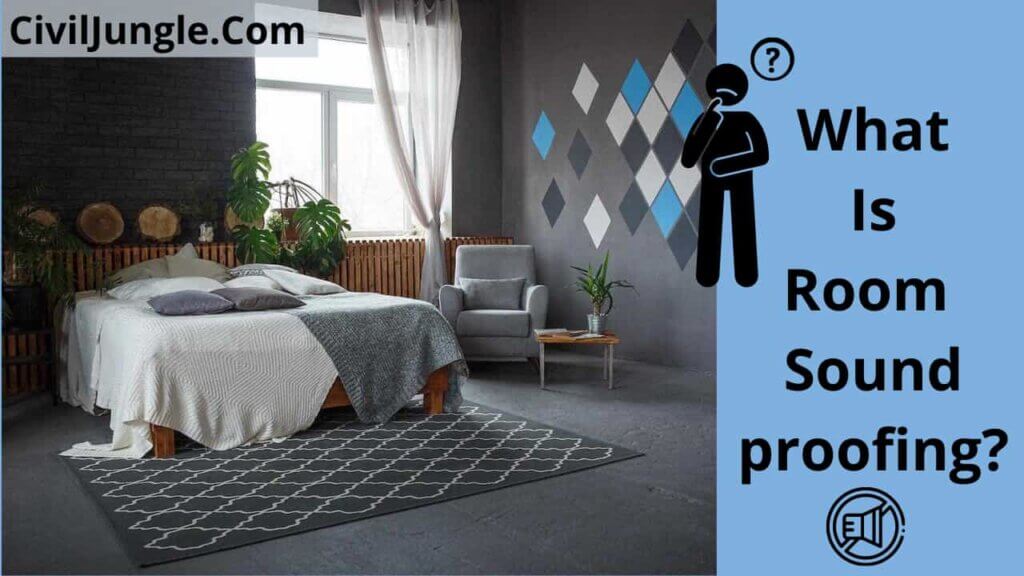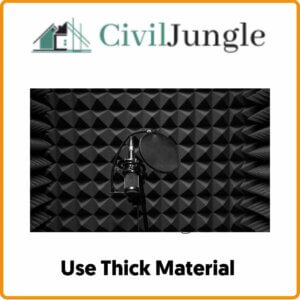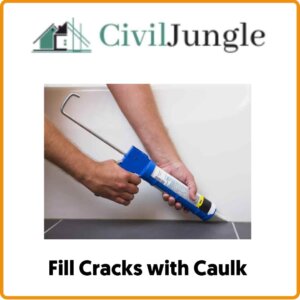Introduction of Room Soundproofing
Important Point
Room soundproofing means blocking the sound from getting in or out of the room. Some special materials are used to obstruct the sound Room soundproofing is needed to get relief from external noise.
What Is Room Soundproofing?
The action to prevent the sound from entering or escaping the room is called room soundproofing. Though there are other processes available to obstruct the sound, room soundproofing is the most suitable one to resolve the issue.
The materials used to soundproof the room are heavy and very dense, so they can reflect the sound and enclose it in a space.
Also, Read: Concrete Construction Tools for Construction Sites
Room Soundproofing Methods
Several methods can help to make a soundproofing room. Some of them are easy or non-constructing methods and others are constructing methods. These methods are described below-
1. Install Thick Carpets
The sound of the walking feet, paws can be annoying. Thicker carpets or mats are sound-absorbing, hence they can be used to muffle the sound of walking.
Vibration insulation pads can also be used with the carpets to mount the sound of the speakers and other noise creating appliances.
2. Seal the Door
If the door frame has any gap at the bottom, sound can easily pass through it. To resolve the issue, installing a draft stopper, or sealing the door bottom is required.
3. Install Thick Blankets
Unwanted sound can be absorbed by mounting thick blankets to the wall. Heavy sound curtains can also give the same advantage.
4. Use Acoustic Panels
Acoustic panels (12×10inches) can absorb frequencies of low to high. Generally, these panels have an adhesive peel with them but in some cases, there is not. In that case, spray adhesive should be used to glue the panels with the walls and ceilings too.
Fiberglass panels are widely used due to their highest rating in sound absorption.
5. Use Thick Material
Drywall of 1.5cm can be used to absorb sound. The material will be of its best use if it is thick and dense enough. A wall frame can be made and attached through the existing wall for the best results
6. Decoupling
While sound travels from one substance to another, little amount of its energy gets absorbed Two sheets of sheetrock can be used to form a wall and the maximum gap between them can enhance the possibility of absorbing sound. It is called Decoupling.
To block low frequencies, Decoupling is used.
7. Stud Placement
A double row of studs or a staggered row of studs can be used instead of using a direct stud that connects both sides of the wall. It is one of the most used soundproofing methods.
8. Use Sound Clips or Channel
They are used to provide an extra barrier of sound between the dry well and the studs. Sound clips have heavy rubber components that help to block the sound.
Sound clips are inserted into the studs, followed by inserting a hat channel that is used to screw the dry well into it. Resilient channels are also used by screwing them through the studs and drywall for blocking high frequencies.
9. Use Damping Compounds
Sound energy is converted to heat by using these compounds. They are also called soundproofing glue. Low frequencies are absorbed by using this glue between layers of the walls, ceilings, etc.
10. Fill Cracks with Caulk
Sometimes small cracks and gaps cause trouble in soundproofing. To solve this problem acoustic caulks are used for filling the gaps Water-based caulk is easy to use but while using solvent-based caulk, it is necessary to check the level.
Otherwise, the materials attached to it can be damaged. Normal caulks are used to handle small gaps but in difficult situations, acoustic caulks can be used.
Also, Read: Hand Level Surveying | What Is Site Level | How to Use a Hand Level | Estimating Distance with a Sight Level
Best Way to Soundproof a Room
There are several ways. Some of them are listed below-
One of the most commonly used ways for soundproofing is Mineral wool insulation, as in comparison to others its cost is low and density is high. At first Spray foam should be used before mineral wool insulation for filling the gaps as a 2-3inch layer.
It is necessary to determine what noise should be absorbed Soft and sound-absorbing materials should be installed like upholstered furniture, rugs etc. Sound-absorbing acoustic tiles should be used.
Sound-blocking doors are needed to install. Noise-proof window inserts or Acoustic quilts have to be installed Sound-blocking wall, ceiling, and floor construction techniques should be explored.
Cost to Soundproof a House
The cost of soundproofing depends on the size of the area. It is almost $15 to $35 per square foot. Soundproofing an entire room can cost up to $1,200 to $2,500. The cost of labor is £30 to £50 per hour or about £400 per day.
Soundproofing Cost By Surface
1. Ceilings: Textured paint to the ceilings can cost up to $250 to $350. Using acoustic foam costs up to $15 to $120 per panel.
2. Walls: Soundproof materials cost up to$2 to $6 per square foot. The cost per sheet of soundproof drywall is $45.
3. Floors: The cost of the carpet is $1,200 per room. Mass-loaded vinyl has an average cost of $140 per 30-square-foot. Mlv will cost up to $400 for a 10 foot by 10-foot Loose-fill insulation has an average cost of $50 to $200.
4. Doors: Soundproofing blankets will cost up to $200 to $400 Soundproofing curtains will cost up to $20 to $80 per panel Sliding glass doors for $1,200 to $4,200.
5. Window: $200 to $1,000 per soundproofing window.
Room Soundproofing
Soundproofing walls involves ripping the existing drywall off the walls (and perhaps the ceiling), filling the walls with fiberglass insulation, attaching metal strips called “resilient channel” to the studs, and fastening new drywall to the channel.
Room Sound Booth
Our sound isolation booths significantly reduce ambient and acoustic noise and can be used as vocal booths for recording music, voice over or translations, as a broadcast booth, musical instrument practice booth, office solutions, medical or audiology testing labs, post-production rooms, and much more.
Cost to Soundproof a House
The cost of soundproofing a room typically ranges between $1,025 and $2,718, with the average being $1,857. The low end of this cost is $600, and the high end is $4,000. Major cost factors include the materials, size of the room and surfaces requiring soundproofing.
Soundproof Modular Rooms
The quality of sound insulation is the same. With the soundproof booth, the aim is to create a reliable and permanently usable workspace for our customers. The choice of interior acoustics depends on the user´s needs.we are your partner for modular acoustic booths with competence in building and room acoustics.
What Is Room Soundproofing?
House Sound Proofing
Doors replacement is a bit expensive way of soundproofing your house but is very useful as the doors are the most common throughway for the sound. An excellent soundproof door should be thick and not hollow. Ensure also there’re no gaps on your doors that can allow the noise to pass through.
Room Soundproofing Methods
Cover walls with thick blankets, moving pads, tapestries, or quilts. Virtually any soft material will work, though thicker ones absorb more sound than thinner materials. If you don’t mind adding an industrial look to the room, fasten sound-absorbing panels to the walls and, if necessary, the ceiling.
Soundproof Sound Booth
A soundproof phone booth is a box (also known as a pod) engineered to ensure that your conversation inside it cannot be overheard. They feature advanced soundproof engineering which allows them to be well ventilated without any sound escaping.
Best Way to Soundproof a Room
The type of drywall you should add is 5/8″ thick. The combined thickness versus the regular drywall in most homes will not only help block noise but will make your wall look better by reducing the chance of it from bowing.
Sound Rooms
A soundproof room is one that blocks sound from entering or leaving a room. 100% soundproofing is rarely achievable and would require a substantial investment which very few people can afford. In this article, you will learn how to soundproof a room almost completely in ways that are most cost-effective but do require some amount of investment.
Soundproof Isolation Booth
Vocal booths are a good choice if your home recording studio only takes up a portion of a room. This is because a home vocal booth isolates your voice from the rest of the room, which, in turn, delivers less reverb and less chance of lopsided sound reflections.
Reduce Noise Window Apartment
This is by far the simplest answer to the problem of window noise. Window plugs are easy to build, are made from inexpensive materials, and are highly effective. They work by filling in the space in front of your windows with layers of acoustic foam, soundproof matting, and wood. The foam at the front absorbs incoming sound waves.
Fully Soundproof Room
When it comes to soundproofing at home, you’re almost guaranteed to get a fully soundproof room. These cost tens of thousands of dollars and take lots of work, which is why they’re mainly only found in professional settings. However, you can still make a massive difference with the tools at your disposal.
Soundproof Your Room Cheap
The cheapest way to soundproof a wall is to use thick blankets and quilts. To block outside noise, put blankets over the walls, doors, or windows, depending on where the sound is coming from. To keep the sound in, hang blankets on both sides of the doors or inside walls.
Home Theater Soundproofing Ceiling
The best way to soundproof your home theater is to line the perimeter walls or ceiling surfaces with sound-absorbing acoustic sound panels, ceiling clouds or acoustic baffles. These are designed to capture and convert unwanted noise from the space.
I Need to Soundproof My Room
To soundproof your room and reduce noise you need to absorb the sound. You can accomplish this by adding acoustic foam and acoustic panels on walls, hang blankets over sound entry points, and position furniture and rugs to help absorb sound. Place the sound absorbing material within the direct path of the sound’s source.
Soundproof Studio Apartment
Sound travels on air, and any gap you can see light through will also let sound through. If you have a large gap under your apartment door, add a door sweep. Use a commercial-grade sweep with a thick rubber strip that seals against the threshold. This will also help keep out dust, bugs, and drafts as well as noise.
Like this post? Share it with your friends!
Suggested Read –
- Large Roofing Companies
- What Is Leveling | 5 Different Types of Leveling Methods
- All About Bituminous Pavement | What Is Bituminous Pavement What IS Bituminous Paving What Is Bituminous Road
- What Is Sewerage System | Types of Sewerage System | Why We Need a Partially Separate System | How Does a Sewage Treatment Plant Work
- What Is Stretcher Bond | Advantages of Stretcher Bond | Disadvantages of Stretcher Bond | Application of Stretcher Bond | Use of Stretcher Bond
- What Is Plate Load Test | Method of Plate Load Test | Limitations of Plate Load Test | What Is Plate Bearing Test Procedure | Advantages & Disadvantages of Plate Load Test
- What Is Limit State Method | Assumption in Limit State of Collapse | Limit State Design | What Is Working Stress Method | Assumptions in Working Stress Method | Working Stress Method of Design
Originally posted 2022-03-19 18:55:09.














Leave a Reply